Protective behavior against Covid-19 among Vietnamese people in the social distancing campaign: A cross-sectional study
In the global fight against the rapid spread of COVID-19, a variety of unprecedented
preventive measures have been implemented across the globe, as well as in Vietnam. How
Vietnamese people respond to threats to their health and life remains unclear. For this
reason, the current study aims to examine Vietnamese people’s protective behavior and its
factors. Based on 1,798 online survey respondents’ data collected on the last three days of
the nationwide social distancing campaign in mid-April, it is found that gender, knowledge
of COVID-19 and preventive measures, and attitudes towards the COVID-19 prevention
policies are the three main factors of participants’ protective behaviors. We also find that
males are less likely than females to adopt precautionary measures. People who are
knowledgeable about COVID-19 may have inappropriate practices towards it. Further
research is needed to examine other determinants of protective behaviors to provide more
useful information for authorities, public health policy-makers, and healthcare workers to
deliver the best practices to control COVID-19 in our country.
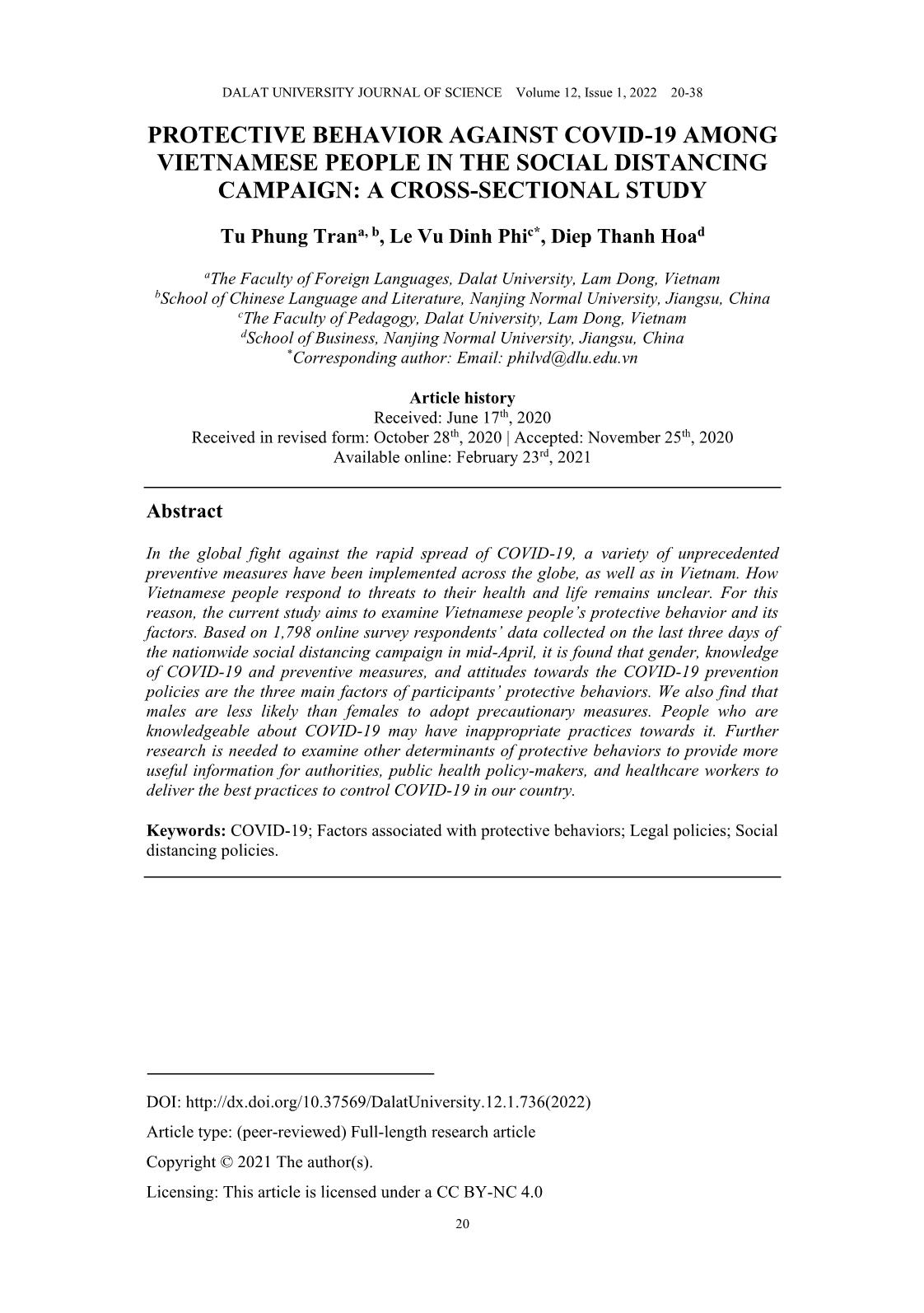
Trang 1
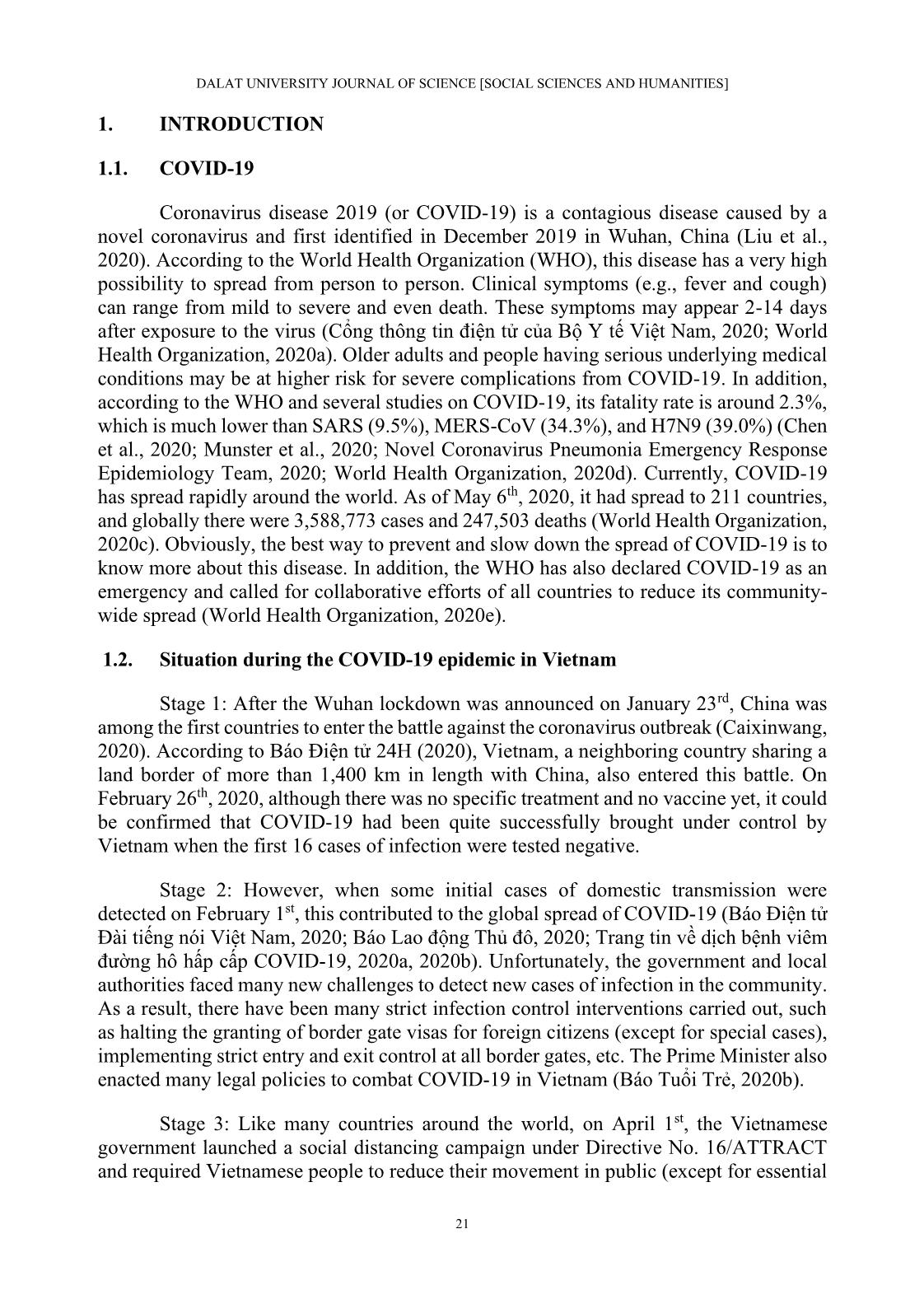
Trang 2
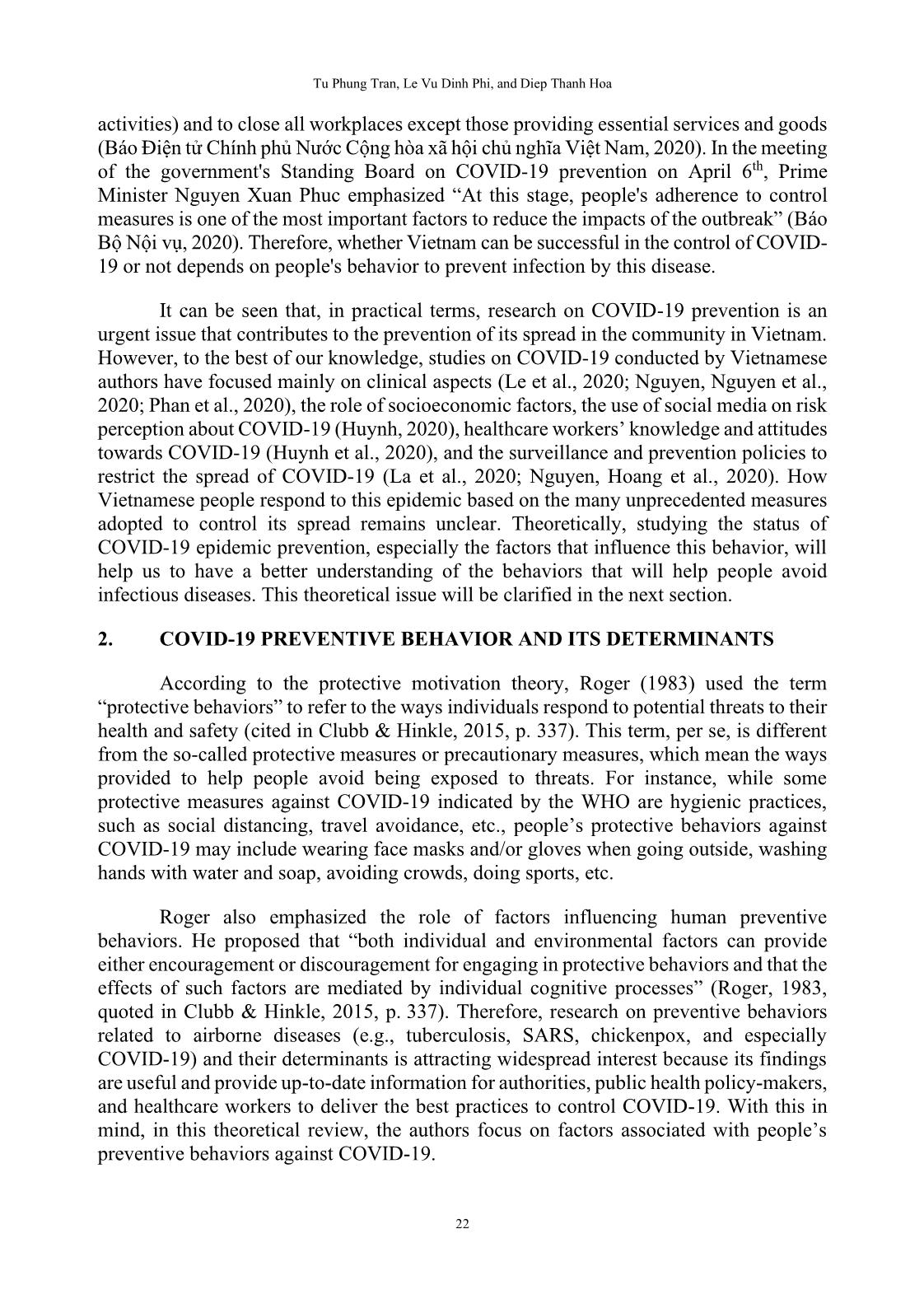
Trang 3
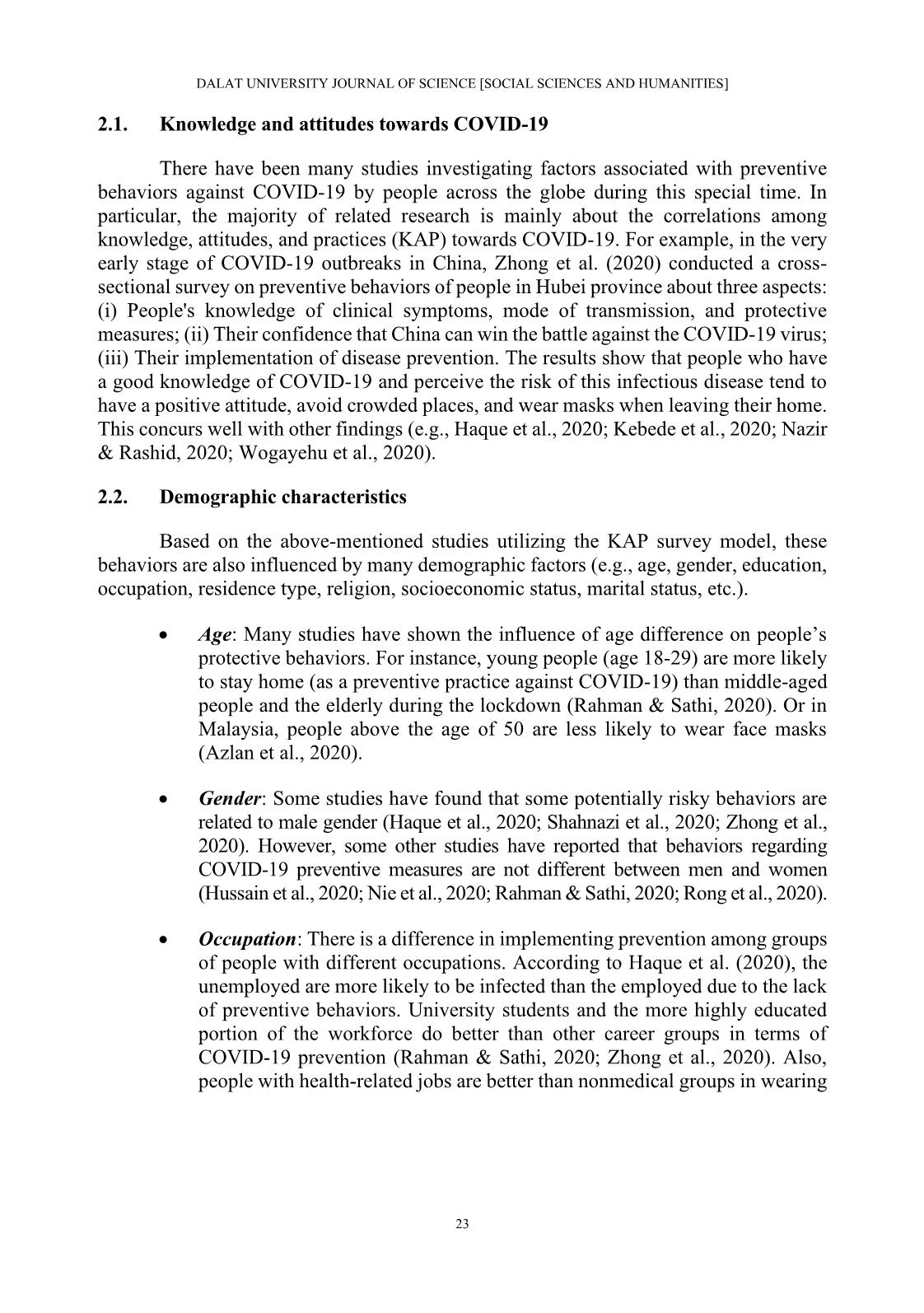
Trang 4
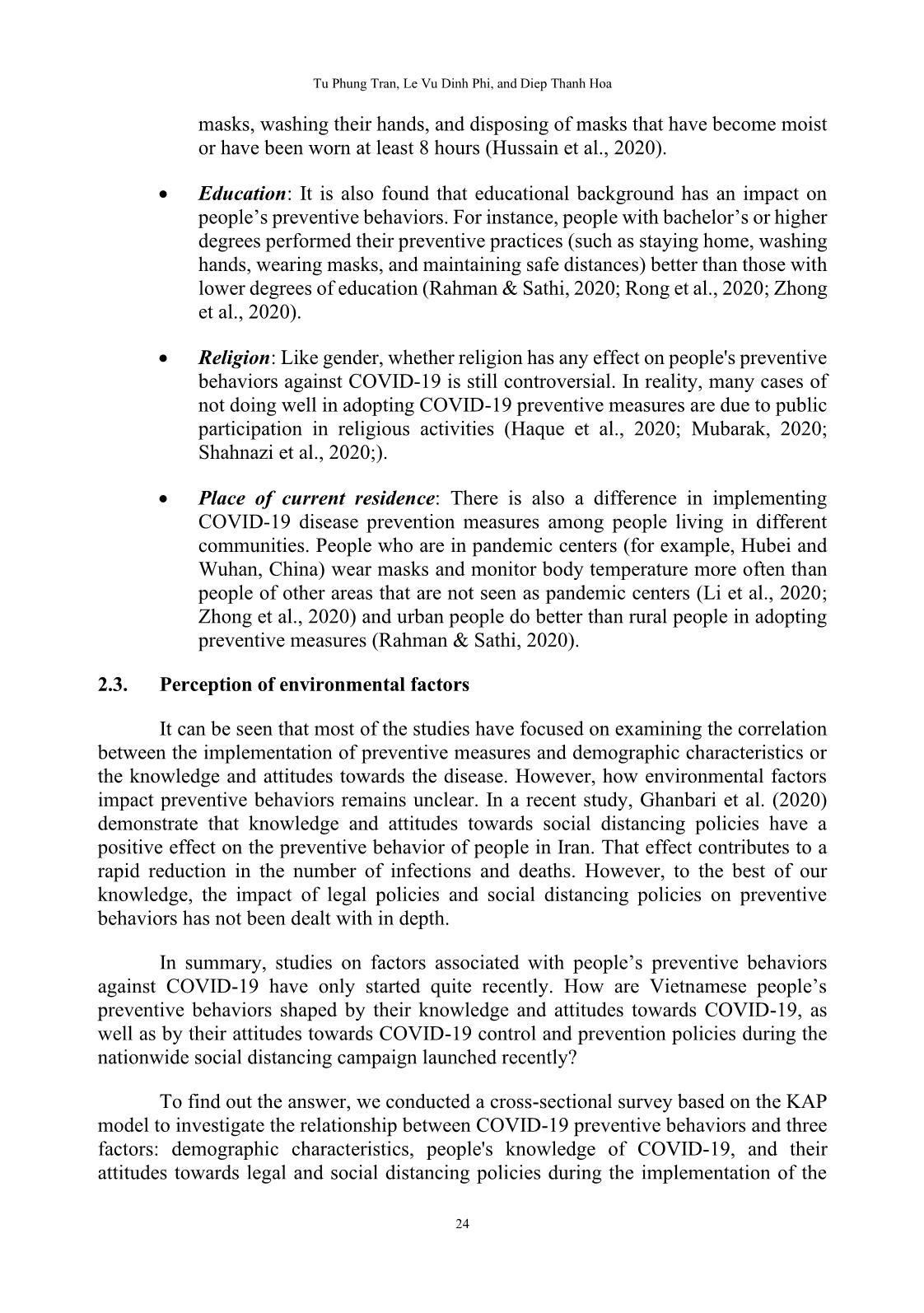
Trang 5
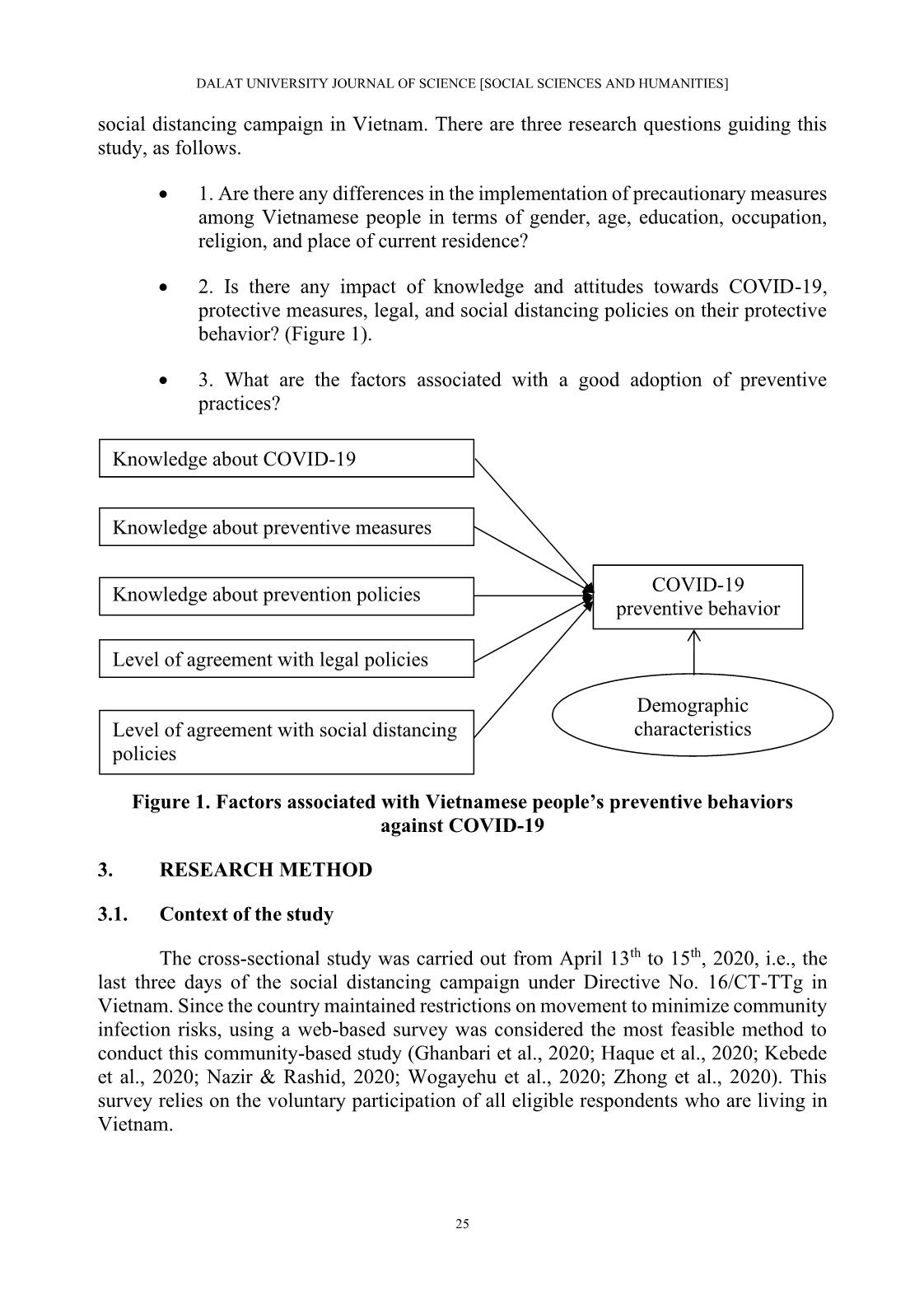
Trang 6
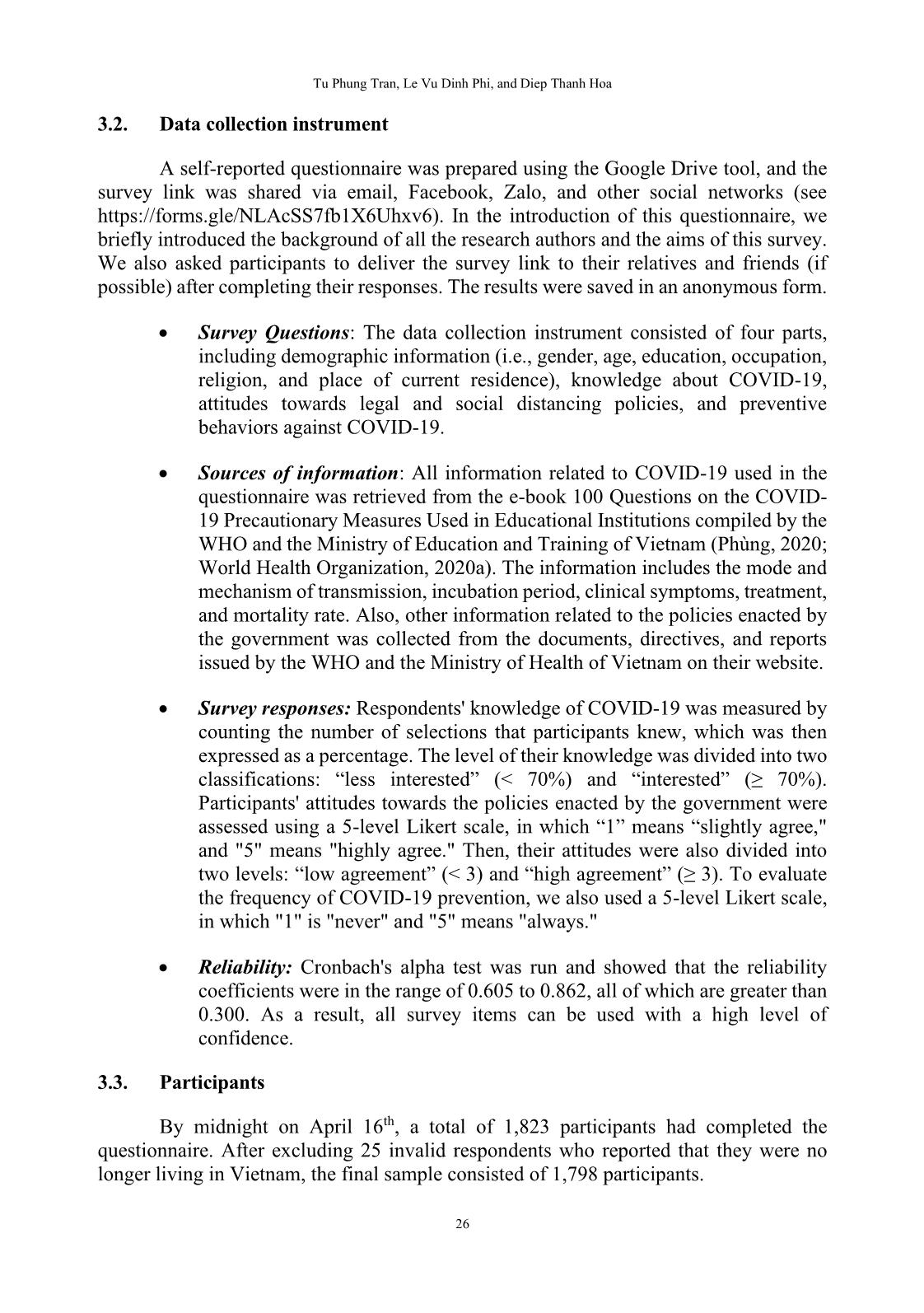
Trang 7
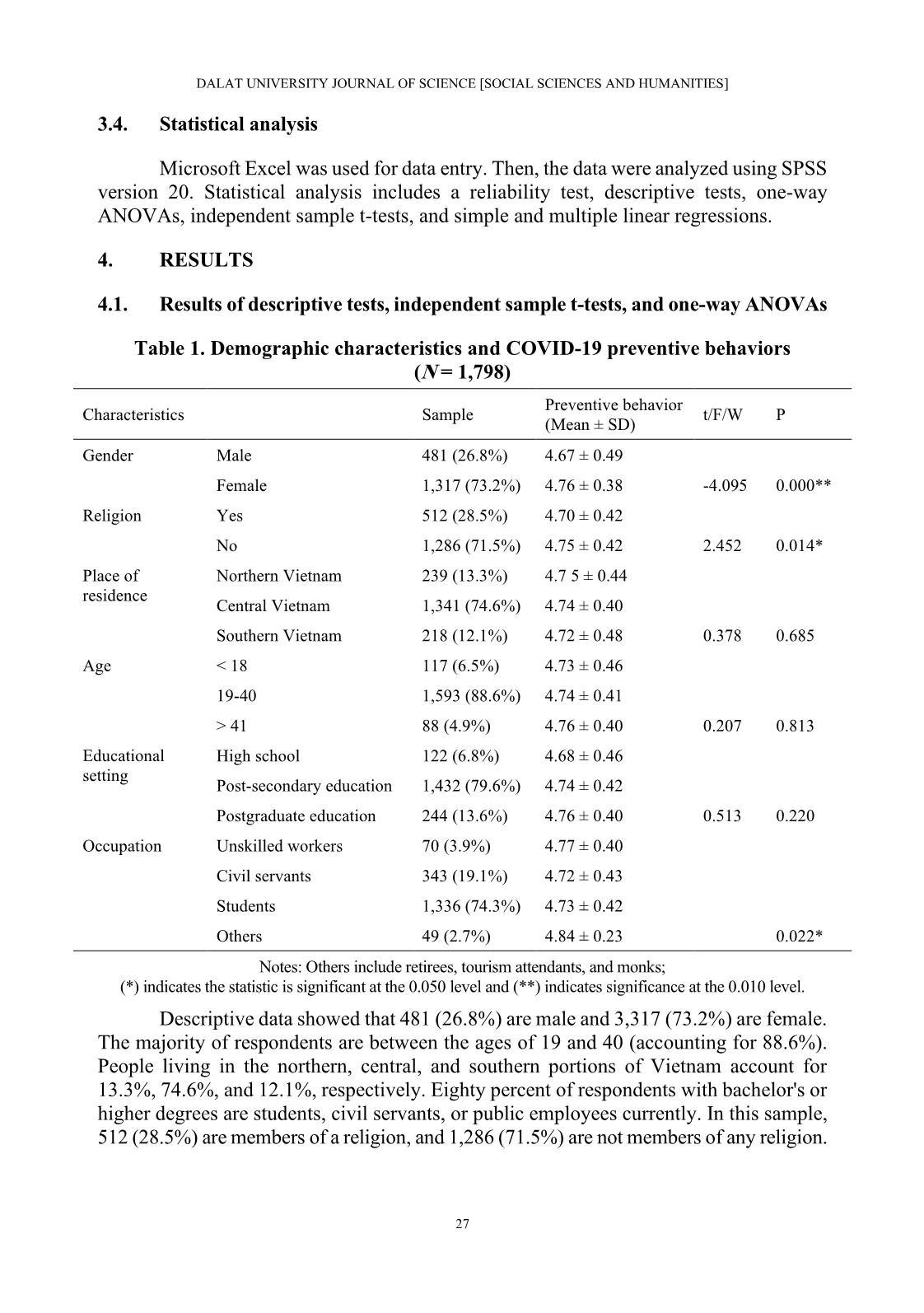
Trang 8
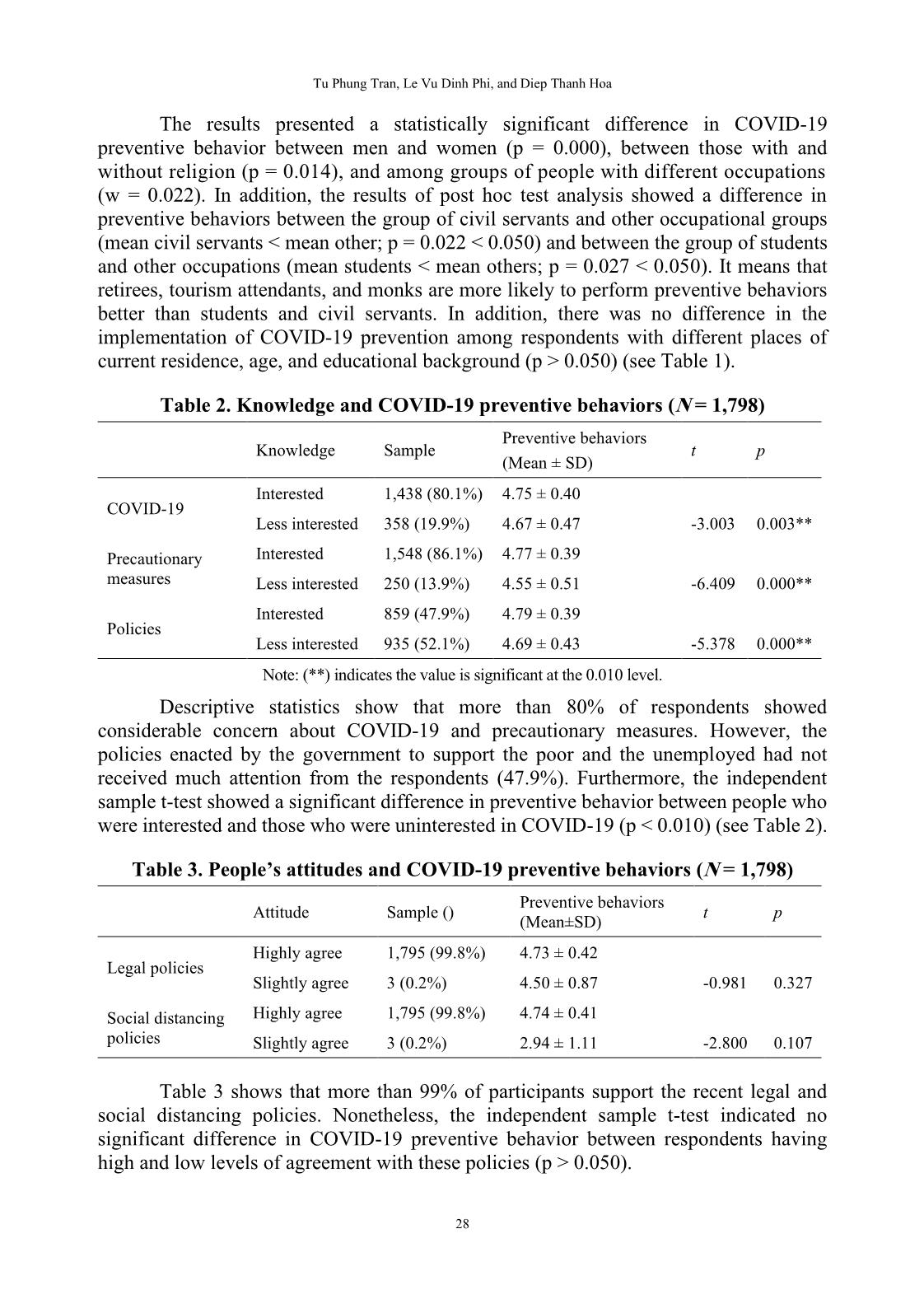
Trang 9
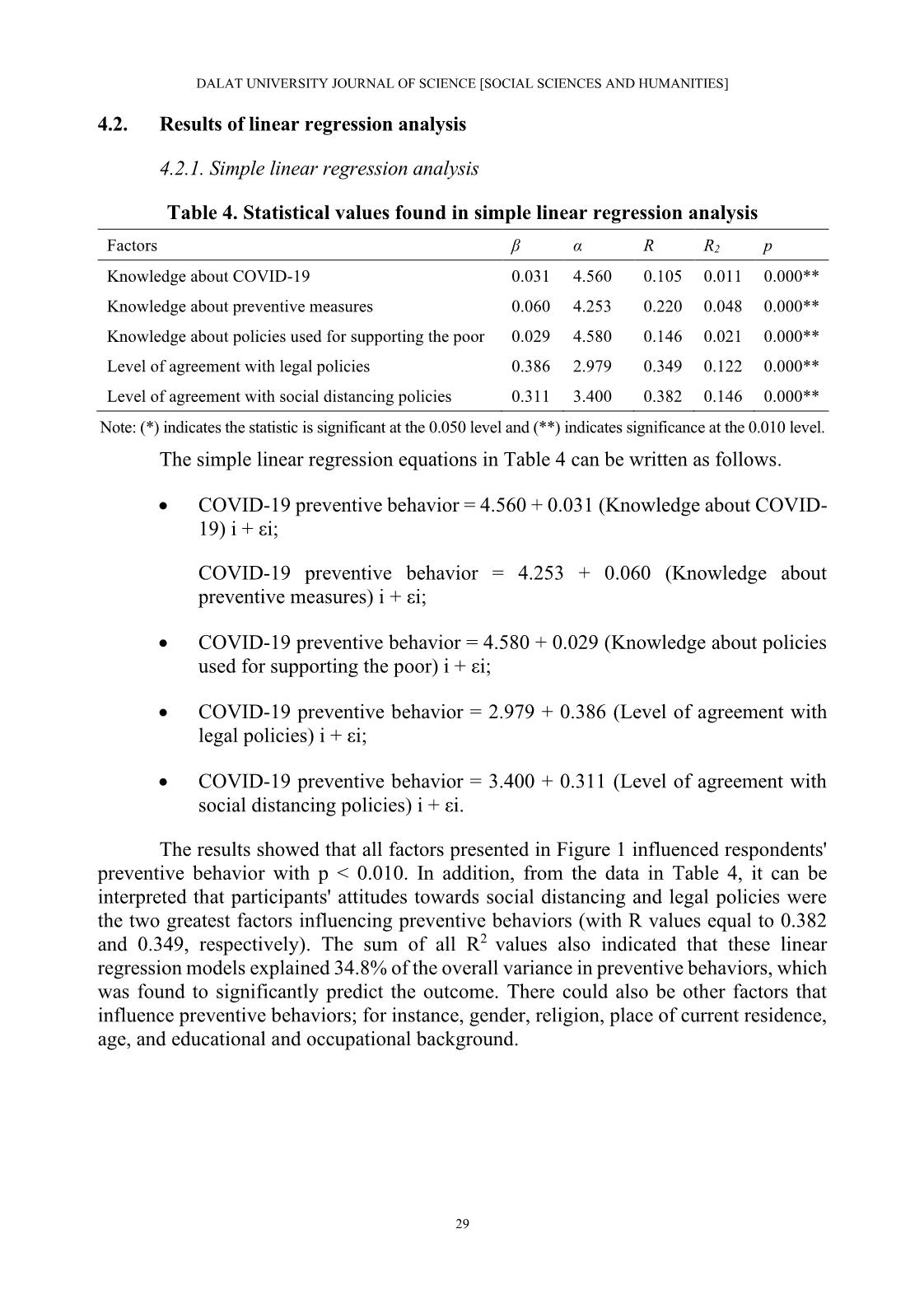
Trang 10
Tải về để xem bản đầy đủ
Tóm tắt nội dung tài liệu: Protective behavior against Covid-19 among Vietnamese people in the social distancing campaign: A cross-sectional study
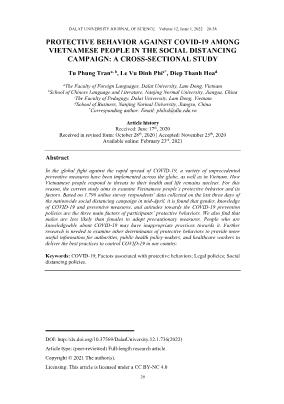
ted in these policies is less than 50%. 5.3. The impact of attitudes toward government-issued policies on preventive behavior The results of the t-test analysis do not show any difference in preventive behaviors between people with high and low consent to government-issued policies (see Table 3). However, from the regression results, it is shown that people's attitude towards these policies plays an important role in having a good adoption of COVID-19 precautionary measures. This means that their good adoption is directly proportional to DALAT UNIVERSITY JOURNAL OF SCIENCE [SOCIAL SCIENCES AND HUMANITIES] 33 their supportive attitude towards the government's anti-epidemic policies. Therefore, to help Vietnamese people have better preventive behaviors, the government should take anti-epidemic policies and their reasonableness into consideration. The results in Table 4 also indicate the importance of people's attitudes towards social distancing policies. In essence, social distancing policies have been playing an important role in limiting the spread of COVID-19 in all nations. For example, the growth rate of new cases and deaths from COVID-19 in China and Iran has significantly decreased after the implementation of social distancing (Ghanbari et al., 2020; Shen, 2020). In Vietnam, there were 268 confirmed cases of COVID-19 and zero fatalities as of April 16th (Báo Dân Trí, 2020; Báo Tuổi Trẻ, 2020a). Vietnam has been a low-risk area compared to other countries in the same geographic region (e.g., 83,745 cases in China, 10,591 cases in South Korea, 8,100 cases in Japan, 5,223 cases in the Philippines, etc.) (World Health Organization, 2020b). It can be seen that these policies and their reasonableness have been creating a base for building an enormous number of young Vietnamese students’ trust in winning the battle against COVID-19, which is considered a strong foundation to help students have good preventive behaviors. 6. CONCLUSION In summary, this cross-sectional study explores the general situation of Vietnamese students’ preventive behaviors during the social distancing campaign in the middle of April and indicates several factors associated with their behaviors. It is believed that the consensus between the government and the people can repel any danger, no matter how demanding it is. However, this cross-sectional online survey was conducted based on a convenience sample that was over-representative of female students. Future research should use a more representative and systematic sampling method to improve the generality of the results. For instance, we should pay more attention to the groups that are vulnerable to the disease, such as unskilled workers and the elderly. Furthermore, our data collection instrument is a self-reported questionnaire. It is possible that participants respond in a positive way to satisfy what they perceive to be expected of them. As a result, studies on preventive behavior assessment should be carried out using other methods, such as telephone interviews, follow-up surveys, etc. ACKNOWLEDGMENTS We gratefully acknowledge the respondents participating in this survey and sincerely thank Tu Phung Ngoc for participating as a content reviewer and translator. REFERENCES Azlan, A. A., Hamzah, M. R., Sern, T. J., Ayub, S. H., & Mohamad, E. (2020). Public knowledge, attitudes and practices towards COVID-19: A cross-sectional study in Malaysia. PLoS ONE, 15(5), 1-15. Tu Phung Tran, Le Vu Dinh Phi, and Diep Thanh Hoa 34 Báo Bộ Nội vụ. (2020). Thủ tướng: Sự chấp hành của người dân là yếu tố quan trọng nhất. https://moha.gov.vn/tin-tuc-su-kien/diem-tin/thu-tuong-su-chap-hanh-cua- nguoi-dan-la-yeu-to-quan-trong-nhat-44032.html Báo Dân Trí. (2020). Thủ tướng: Tranh thủ giai đoạn vàng, quyết liệt chống dịch Covid- 19. https://dantri.com.vn/xa-hoi/thu-tuong-tranh-thu-giai-doan-vang-quyet-liet- chong-dich-covid-19-20200316195549954.htm Báo Điện tử 24H. (2020). Bộ Y tế lý giải vì sao 16 bệnh nhân nhiễm Covid-19 tại Việt Nam đều khỏi bệnh. https://www.24h.com.vn/tin-tuc-trong-ngay/bo-y-te-ly-giai- vi-sao-16-benh-nhan-nhiem-covid-19-tai-viet-nam-deu-khoi-benh-c46a1127209. html Báo Điện tử Chính phủ Nước cộng hòa xã hội chủ nghĩa Việt Nam. (2020). Thủ tướng chỉ thị: Cách ly toàn xã hội từ 0 giờ 1/4 trên phạm vi toàn quốc. 14-tren-pham-vi-toan-quoc/391485.vgp Báo Điện tử Đài Tiếng nói Việt Nam. (2020). Việt Nam ghi nhận ca nhiễm Covid-19 thứ 17. https://vov.vn/tin-24h/viet-nam-ghi-nhan-ca-nhiem-covid19-thu-17-1018707 .vov. Báo Lao động Thủ đô. (2020). Kiểm soát chặt việc xuất, nhập cảnh. Báo Tuổi trẻ. (2020a). Dịch COVID-19 chiều 15-4: Không ca nhiễm mới, 171 người đã ra viện. https://tuoitre.vn/dich-covid-19-chieu-15-4-khong-ca-nhiem-moi-171- nguoi-da-ra-vien-20200415180659341.htm Báo Tuổi trẻ. (2020b). Từ 0h ngày 18-3, tạm ngừng cấp thị thực cho người nước ngoài nhập cảnh Việt Nam. https://tuoitre.vn/tu-0h-ngay-18-3-tam-ngung-cap-thi-thuc- cho-nguoi-nuoc-ngoai-nhap-canh-viet-nam-20200317180557605.htm Caixinwang. (2020). Pneumonia Diary: a pneumonia outbreak in Wuhan. Chen, N., Zhou, M., Dong, X., Qu, J., Gong, F., Han, Y., Qiu, Y., Wang, J., Liu, Y., Wei, Y., Xia, J., Yu, T., Zhang, X., & Zhang, L. (2020). Epidemiological and clinical characteristics of 99 cases of 2019 novel coronavirus pneumonia in Wuhan, China: A descriptive study. The Lancet, 395, 507-513. Clubb, A. C., & Hinkle, J. C. (2015). Protection motivation theory as a theoretical framework for understanding the use of protective measures. Criminal Justice Studies, 28(3), 336-355. Cổng thông tin điện tử của Bộ Y tế Việt Nam (2020). Cẩm nang hỏi-đáp thông tin về bệnh viêm đường hô hấp cấp do chủng mới vi rút corona (nCov). https://moh.gov.vn/tin-tong-hop/-/asset_publisher/k206Q9qkZOqn/content/cam- nang-hoi-ap-thong-tin-ve-benh-viem-uong-ho-hap-cap-do-chung-moi-vi-rut- corona-ncov- DALAT UNIVERSITY JOURNAL OF SCIENCE [SOCIAL SCIENCES AND HUMANITIES] 35 Ghanbari, M. K., Behzadifar, M., Imani-Nasab, M. H., Behzadifar, M., Bakhtiari, A., Mir, I., Wu, J., & Bragazzi, N. L. (2020). The impact of the social distancing policy on COVID-19 new cases in Iran: Insights from an interrupted time series analysis. Research Square. https://www.researchsquare.com/article/rs-25818/v1 Haque, T., Hossain, K. M., Bhuiyan, M. M. R., Ananna, S. A., Chowdhury, S. H., Ahmed, A., & Rahman, M. M. (2020). Knowledge, attitude and practices (KAP) towards COVID-19 and assessment of risks of infection by SARS-CoV-2 among the Bangladeshi population: An online cross sectional survey. Research Square. https://www.researchsquare.com/article/rs-24562/v1 Hussain, A., Garima, T., Singh, B., Ram, R., & Tripti, R. (2020). Knowledge, attitudes, and practices towards COVID-19 among Nepalese residents: A quick online cross-sectional survey. Asian Journal of Medical Sciences, 11(3), 6-11. Huynh, G., Nguyen, T. N. H, Tran, V. K., Vo, K. N., Vo, V. T., & Pham, L. A. (2020). Knowledge and attitude toward COVID-19 among healthcare workers at District 2 Hospital, Ho Chi Minh City. Asian Pacific Journal of Tropical Medicine, 13(6), 1-6. Huynh, T. L. D. (2020). The COVID-19 risk perception: A survey on socioeconomics and media attention. Economics Bulletin, 40(1), 758-764. Kebede, Y., Yitayih, Y., Birhanu, Z., Mekonen, S., & Ambelu, A. (2020). Knowledge, perceptions and preventive practices towards COVID-19 among Jimma University Medical Center visitors, Southwest Ethiopia. Research Square, 15(5), 1-15. La, V. P., Pham, T. H., Ho, M. T., Nguyen, M. H., Nguyen, P. K. L., Vuong, T. T., Nguyen, T. H. K., Tran, T., Khuc, Q., Ho, M. T., & Vuong, Q. H. (2020). Policy response, social media and science journalism for the sustainability of the public health system amid the COVID-19 outbreak: The Vietnam lessons. Sustainability, 12(7), 1-27. Le, V. T., Nghiem, M. N., Bui, T. T. T., Le, T. T. U., Nguyen, T. T. H., Nguyen, T. P. D., Le, N. T. N., Tran, T. T., Dinh, N. H. M., Nguyen, T. P., Tran, T. H., Nguyen, T. T., Thwaites, G., & Nguyen, V. V. C. (2020). Duration of viral detection in throat and rectum of a patient with COVID-19. https://www.medrxiv.org/content/10. 1101/2020.03.07.20032052v1 Li, W. H., Liu, B., Liu, M., Zhao, X. H., & Chen, Q. S. (2020). Investigation and analysis of public cognition and prevention awareness of Corona Virus Disease 2019 inside and outside Hubei Province. Journal of Jinan University, 41(2), 186-193. Lin, Y. L., Huang, L. J., Nie, S. F., Liu, Z. Y., Yu, H. J., Yan, W. R., & Xu, Y.H. (2011). Knowledge, attitudes and practices (KAP) related to the pandemic (H1N1) 2009 among Chinese general population: A telephone survey. BMC Infectious Diseases, 11(1), 1-9. Liu, Y. F., Liu, L. N., Wang, Y., Du, X. Y., Ma, H., & Yao, J. (2020). Clinical course and characteristics of patients with 2019 novel coronavirus disease in Wuhan, China: Tu Phung Tran, Le Vu Dinh Phi, and Diep Thanh Hoa 36 A single-centered, retrospective, observational study. Research Square. https://www.researchsquare.com/article/rs-26427/v1 Mubarak, N. (2020). Corona and clergy: The missing link for an effective social distancing in Pakistan. Time for some unpopular decisions. International Journal of Infectious Diseases, 95, 431-432 Munster, V. J., Koopmans, M., van Doremalen, N., van Riel, D., & de Wit, E. (2020). A novel coronavirus emerging in China - Key questions for impact assessment. New England Journal of Medicine, 382, 692-694. Nazir, S. & Rashid, A. (2020). Knowledge, attitudes and practices among residents of Kashmir towards Covid-19 pandemic. International Journal of Medical Science and Innovative Research, 5(2), 130-135. Nepal, R., Sapkota, K., Adhikari, K., Paudel, P., Adhikari, B., Paudyal, N., Sapkota, K., & Nepal, R. (2020). Knowledge, attitude and practice regarding COVID-19 among healthcare workers in Chitwan, Nepal. Research Square. https://www.researchsquare.com/article/rs-26774/v1 Nie, S. N., Cao, J., Tuo, A., & Zheng, Y. C. (2020). Public's status of KAP for COVID- 19 and its influencing factors. Shanghai Preventive Medicine. https://pesquisa.bvsalud.org/global-literature-on-novel-coronavirus-2019-ncov/ resource/en/czh-284 Nguyen, M. D., Hoang, D. H., Tran, A. T., Mai, T. L. B., Pham, H. D. & Pham, M. T. (2020). From first COVID-19 case to current outbreak: A Vietnamese report. Electronic Journal of General Medicine, 17(4), 1-4. Nguyen, T. H., Nguyen, V. T., Ngo, T. T. H., Nghiem, V. B., Doan, T. B., Phung, T. T. H. & Nguyen, T. K. A. (2020). Outbreak investigation for COVID-19 in northern Vietnam. The Lancet Infectious Diseases, 20(5), 535-536 Novel Coronavirus Pneumonia Emergency Response Epidemiology Team. (2020). The epidemiological characteristics of an outbreak of 2019 novel coronavirus diseases (COVID-19)-China. China CDC Weekly, 2(8), 113-122. Pawlowski, B., Atwal, R., & Dunbar, R. I. M. (2008). Sex differences in everyday risk- taking behavior in humans. Evolutionary Psychology, 6(1), 29-42. Phan, T. L., Nguyen, V. T., Luong, C. Q., Nguyen, V. T., Nguyen, T. H., Le, Q. H., Nguyen, T. T., Cao, M. T., & Pham, D. Q. (2020). Importation and human-to- human transmission of a novel coronavirus in Vietnam. The New England Journal of Medicine, 382(9), 872-874. Phùng, X. N. (2020). 100 câu hỏi - đáp về phòng, chống dịch bệnh covid-19 trong các cơ sở giáo dục. NXB Bộ Giáo dục và Đào tạo. Rahman, A. & Sathi, N. J. (2020). Knowledge, attitude, and preventive practices toward COVID-19 among Bangladeshi internet users. Electronic Journal of General Medicine, 17(5), 1-6. DALAT UNIVERSITY JOURNAL OF SCIENCE [SOCIAL SCIENCES AND HUMANITIES] 37 Rong, H., Duan, R. & Chen, X. J. (2020). Study on the rural residents’ knowledge, attitude and practice on COVID-19 and their coping styles. Journal of Chengdu Medical College, 1-7. Shahnazi, H., Ahmadi-Livani, M., Pahlavanzadeh, B., Rajabi, A., Hamrah, M. S., & Charkazi, A. (2020). Assessing preventive health behaviors from COVID-19 based on the health belief model (HBM) among people in Golestan Province: A cross-sectional study in Northern Iran. Research Square. https://www.research square.com/article/rs-24871/v1 Shen, J. F. (2020). Analyzing the determinants of the spread of covid-19 among the provincial regions in China. Research Square. https://www.researchsquare. com/article/rs-26465/v1 Trang tin về dịch bệnh viêm đường hô hấp cấp COVID-19. (2020a). Thực hiện tốt khoanh vùng, dập dịch để hạn chế lây lan dịch COVID-19 ra cộng đồng. https://ncov.moh.gov.vn/web/guest/-/thuc-hien-tot-khoanh-vung-dap-dich-e- han-che-lay-lan-dich-covid-19-ra-cong-ong Trang tin về dịch bệnh viêm đường hô hấp cấp COVID-19. (2020b). Rút ngay giấy phép hiệu thuốc tăng giá khẩu trang mà không cần thanh tra. https://ncov.moh.gov.vn/web/guest/-/rut-ngay-giay-phep-hieu-thuoc-tang-gia- khau-trang-ma-khong-can-thanh-tra Wogayehu, B., Taye, W., Chisha, Y. & Faraja, K. (2020). Knowledge regarding 2019 novel coronavirus (2019-nCoV) infection among final year health science students at Arbaminch College of Health Sciences, Southern Ethiopia: A cross- sectional study. Research Square. https://www.researchsquare.com/article/rs- 24777/v1 World Health Organization. (2020a). Coronavirus. https://www.who.int/health- topics/coronavirus#tab=tab_3 World Health Organization. (2020b). Coronavirus disease (COVID-19) Situation Report– 6. https://www.who.int/emergencies/diseases/novel-coronavirus-2019/situation- reports. World Health Organization. (2020c). Coronavirus disease (COVID-19) Situation Report– 107. https://www.who.int/docs/default-source/coronaviruse/situation-reports/202 00506covid-19-sitrep-107.pdf? World Health Organization. (2020d). Middle East respiratory syndrome coronavirus (MERS-CoV) – Saudi Arabia. https://www.who.int/csr/don/05-may-2020-mers- saudi-arabia/en/ World Health Organization. (2020e). WHO Director-General's statement on IHR Emergency Committee on Novel Coronavirus (2019-nCoV). https://www. who.int/dg/speeches/detail/who-director-general-s-statement-on-ihr-emergency- committee-on-novel-coronavirus-(2019-ncov). Zhong, B. L., Luo, W., Li, H. M., Zhang, Q. Q., Liu, X. G., Li, W.T., & Li, Y. (2020). Knowledge, attitudes, and practices towards COVID-19 among Chinese residents Tu Phung Tran, Le Vu Dinh Phi, and Diep Thanh Hoa 38 during the rapid rise period of the COVID-19 outbreak: A quick online cross- sectional survey. International Journal of Biological Sciences, 16(10), 1745- 1752. Zeng, Q. & Zheng, X. F. (2018). The gender difference between conditional acquisition of disgust and fear: An ERPs investigation. Studies of Psychology and Behavior, 16(5), 624-631.
File đính kèm:
 protective_behavior_against_covid_19_among_vietnamese_people.pdf
protective_behavior_against_covid_19_among_vietnamese_people.pdf

